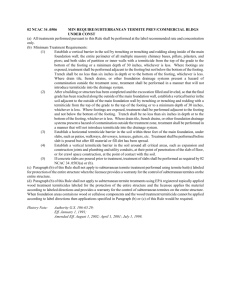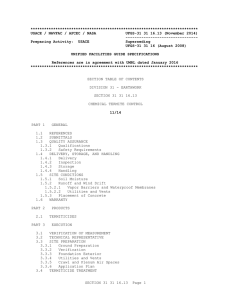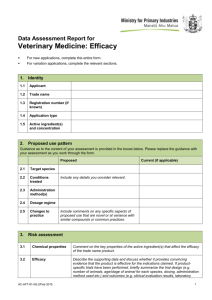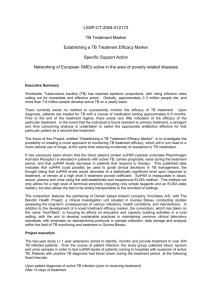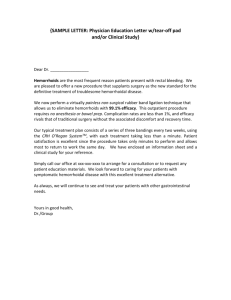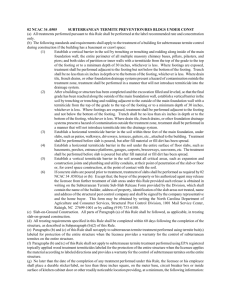Full paper - Icup.org.uk
advertisement
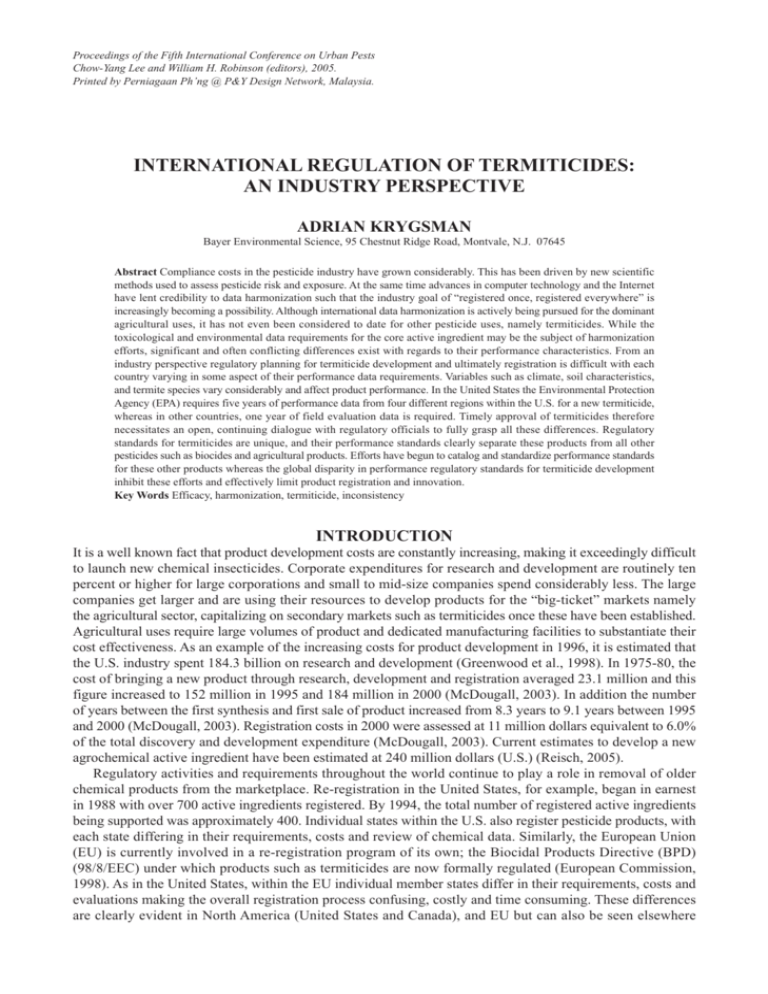
Proceedings of the Fifth International Conference on Urban Pests Chow-Yang Lee and William H. Robinson (editors), 2005. Printed by Perniagaan Ph’ng @ P&Y Design Network, Malaysia. INTERNATIONAL REGULATION OF TERMITICIDES: AN INDUSTRY PERSPECTIVE ADRIAN KRYGSMAN Bayer Environmental Science, 95 Chestnut Ridge Road, Montvale, N.J. 07645 Abstract Compliance costs in the pesticide industry have grown considerably. This has been driven by new scientific methods used to assess pesticide risk and exposure. At the same time advances in computer technology and the Internet have lent credibility to data harmonization such that the industry goal of “registered once, registered everywhere” is increasingly becoming a possibility. Although international data harmonization is actively being pursued for the dominant agricultural uses, it has not even been considered to date for other pesticide uses, namely termiticides. While the toxicological and environmental data requirements for the core active ingredient may be the subject of harmonization efforts, significant and often conflicting differences exist with regards to their performance characteristics. From an industry perspective regulatory planning for termiticide development and ultimately registration is difficult with each country varying in some aspect of their performance data requirements. Variables such as climate, soil characteristics, and termite species vary considerably and affect product performance. In the United States the Environmental Protection Agency (EPA) requires five years of performance data from four different regions within the U.S. for a new termiticide, whereas in other countries, one year of field evaluation data is required. Timely approval of termiticides therefore necessitates an open, continuing dialogue with regulatory officials to fully grasp all these differences. Regulatory standards for termiticides are unique, and their performance standards clearly separate these products from all other pesticides such as biocides and agricultural products. Efforts have begun to catalog and standardize performance standards for these other products whereas the global disparity in performance regulatory standards for termiticide development inhibit these efforts and effectively limit product registration and innovation. Key Words Efficacy, harmonization, termiticide, inconsistency INTRODUCTION It is a well known fact that product development costs are constantly increasing, making it exceedingly difficult to launch new chemical insecticides. Corporate expenditures for research and development are routinely ten percent or higher for large corporations and small to mid-size companies spend considerably less. The large companies get larger and are using their resources to develop products for the “big-ticket” markets namely the agricultural sector, capitalizing on secondary markets such as termiticides once these have been established. Agricultural uses require large volumes of product and dedicated manufacturing facilities to substantiate their cost effectiveness. As an example of the increasing costs for product development in 1996, it is estimated that the U.S. industry spent 184.3 billion on research and development (Greenwood et al., 1998). In 1975-80, the cost of bringing a new product through research, development and registration averaged 23.1 million and this figure increased to 152 million in 1995 and 184 million in 2000 (McDougall, 2003). In addition the number of years between the first synthesis and first sale of product increased from 8.3 years to 9.1 years between 1995 and 2000 (McDougall, 2003). Registration costs in 2000 were assessed at 11 million dollars equivalent to 6.0% of the total discovery and development expenditure (McDougall, 2003). Current estimates to develop a new agrochemical active ingredient have been estimated at 240 million dollars (U.S.) (Reisch, 2005). Regulatory activities and requirements throughout the world continue to play a role in removal of older chemical products from the marketplace. Re-registration in the United States, for example, began in earnest in 1988 with over 700 active ingredients registered. By 1994, the total number of registered active ingredients being supported was approximately 400. Individual states within the U.S. also register pesticide products, with each state differing in their requirements, costs and review of chemical data. Similarly, the European Union (EU) is currently involved in a re-registration program of its own; the Biocidal Products Directive (BPD) (98/8/EEC) under which products such as termiticides are now formally regulated (European Commission, 1998). As in the United States, within the EU individual member states differ in their requirements, costs and evaluations making the overall registration process confusing, costly and time consuming. These differences are clearly evident in North America (United States and Canada), and EU but can also be seen elsewhere 1 452 Adrian Krygsman throughout the world. The net result is the driving up of product development costs making it more difficult to enter the market. Industry concerns over resources have led to a call for a “universal registration” in which a product is registered once and subsequently registered everywhere. This is a lofty goal and it remains to be seen if it is possible. At this time “data harmonization” is a goal that industry and government officials alike are discussing and working towards. Efforts at harmonizing data are numerous; the Organization for Economic Cooperation and Development (OECD) has had a number of international meetings between regulators, industry and trade associations in an effort to harmonize electronic templates for data submissions. The North American Free Trade Agreement (NAFTA) Technical Working Group on Pesticides has been working since early 1990 to coordinate and harmonize regulatory activities (USPEA, 2004). This has resulted in efforts by the U.S. and Canada to announce their commitment to a global approach to agricultural pesticide regulation (Pesticide & Toxic Chemical News, 2005). The Occupational Safety and Health Administration (OSHA) has initiated a program to harmonize the communication of hazards through Material Safety Data Sheets (MSDS) in the U.S. with the goal to harmonize these documents with the rest of the world (Ritter, 2005). The USEPA has most recently published a draft for labeling and classification of pesticides according to the Global Harmonized System or GHS (USEPA, 2004). Attempts have also been made to survey available methods of efficacy for pesticide products to begin the process of harmonization of this important regulatory requirement. Aside from toxicological data are there efforts to examine efficacy requirements and harmonize this set of data needs? With all this flurry of activity around pesticides what is happening with termiticides? Are there harmonization activities occurring with these products? Termiticides are unique in that, other than disinfectants, efficacy data is a key component of their registration. Agricultural products in North and South America, for the most part, do not need this data included in the registration dossier before registration is granted. It is not considered crucial to the overall evaluation by regulators and in countries like the U.S. the competent authority reserves the right to request this data at any time. In many cases regulators let the market decide whether products are efficacious and harmonization then, is merely an afterthought. Poor efficacy for these products can be demonstrated for the most part in one growing season. While termiticides play an important role in preserving natural resources, simplifying efficacy requirements has not been a concern of government regulators. While this data is key to a termiticides registration it often conflicts with a competent authorities mandate that is to protect man and the environment. Efficacy data then is reduced to a lower status in the evaluation process and inconsistencies often occur with its interpretation and significance. Unlike agricultural products, efficacy for termiticides is problematic. It may not be known for years if a termiticide has truly eradicated a termite infestation. Considering the importance and costs of a home to the consumer they can be at a significant risk and waiting for the market to “weed” out problematic products is simply not an option. The mandate for consumer protection versus protection of man and the environment is truly a dilemma for termiticides. A problem at this point in time is agreement on the necessary efficacy standards for termiticides. Standards are available in some countries but they differ by country and region. De facto standards have existed for some time in the U.S. by the United States Department of Agriculture Forest Service (USDA/FS), the primary government agency involved in termiticide efficacy testing. It was only in 1996 that the U.S. Environmental Protection Agency published its own public registration (PR) notice concerning the labeling and performance standard for soil applied termiticides (USEPA, 1996). Since then, EPA has published additional guidelines for bait products and states such as Florida have established their own standard for termiticides in the preconstruction area (Florida, 2004). Although EPA has standards and guidelines which indicate how performance is conducted elsewhere in the world requirements differ and cannot be called standard. Differing standards/guidelines require additional expenditures and rather than registered once, registered everywhere, considerable efforts are necessary to register a termiticide in key markets throughout the world. Table 1 lists various regulatory agencies that regulate termiticides. International Regulation Of Termiticides An Industry Perspective 453 Table 1. Regulatory Authorities Requiring Termiticide Testing and Registration Country Authority Regulation Australia Australian Pesticides & Veterinary Medicines Authority (APVMA) Agricultural and Veterinary Chemicals Code Act (Amended) 1994- Part 8 Efficacy and Safety to Target Plants Brazil Instituto Brasileiro do Meio Ambiente (IBAMA) Secretario da Vigilância Sanitária (MS) Ordinance 321 of Ministry of HealthANVISA (household products) Ministry of Environment Legislation NI5/92 and Ordinance 292/89 treatment to wood after cut European Union EU Commission-Brussels Individual Member State Authorities Biocidal Products Directive 98/8/EEC-Product Type 18Insecticides Annex VI Individual Member State such as France: Centre Technique du Bois et de l’Ameublement Japan Ministry of Agriculture (MITI) Japan Wood Preservation Product Evaluation Organization (JWPA), Japan Termite Control Association (JTCA) South Africa South African Ministry of Agriculture South African Bureau of Standards (SABS) Registrar Act 36 of 1947, South African Standard Method 859:1993 (first edition); South African Standard Method SANS 5859: 2003 (Edition 3) United States US. Environmental Protection Agency (EPA), Individual States via Association of Structural Pest Control Regulatory Officials (ASPCRO) Federal Insecticide Fungicide and Rodenticide Act OPPTS Series 810:3600 Product Performance Test Guidelines Structural Treatments, OPPTS Series 810:3800 Product Performance Test Guidelines, Methods for Efficacy Testing of Termite Baits MATERIALS AND METHODS Resources such as government websites and standard authorities were consulted to obtain information on the various guidelines that exist for termiticides. Sites consulted were: Country/Organization Association of Structural Pest Control Regulatory Officials Australia National Registration Authority Brazilian Institute for Environment and Renewable Natural Resources Centre Technique du Bois et de l’Ameublemt Website http://ASPCRO.org www.standards.com.au www.IBAMA.gov www.CTBA.FR/ 454 Country/Organization European Commission Japan Adrian Krygsman Website http://ecb.jrc.it/menu http://www.soc.nii.ac.jp/jwpa/english/what/html United States www.epa.gov/pesticides/ South Africa www.sabs.co.za/ Closer examination of each countries requirements for termiticide efficacy illustrate the various ways overall product performance is conducted and evaluated. Australia General guidelines exist for the efficacy studies based on the APVMA Part 8 Efficacy and Crop Safety. Specific guidelines are found in Australian standard AS3660 (Protection of Buildings from Subterranean Termites, and Assessment Criteria for Termite Management Systems). Studies are recommended to be conducted: under Australian conditions; at the optimum application rate over at least two seasons; untreated controls should be used; statistically valid study designs should be incorporated. It provides a standard for conducting laboratory and field studies for termiticides. Note that field studies will require a permit from the National Registration Authority (NRA) before proceeding. The Australian standard “Termite Management, Part 3: Assessment Criteria for Termite Management systems is similar to the USEPA Product Performance Test Guidelines, OPPTS Series 810:3600. The major difference is that while the USEPA provides separate guidelines for bait products and soil applied termiticides the Australian standard combines guidelines for both types of products along with physical barriers and sampling techniques for testing the uniformity of horizontal and vertical chemical soil barriers with procedures for addressing termite colony eradication. Finally the Australian standard also provides a soil sampling protocol for determining the lowest expected threshold values for horizontal and vertical chemical barriers. Interestingly, no assessment criteria are provided for assessing termiticide performance. Ultimately, once laboratory data and field studies have been provided to the NRA, determination of acceptability rests in their hands. That is, the authorities will accept some minimal degree of damage, but is it uniform and consistent for everyone? Bayer Environmental Science (BES) conducted three years of imidacloprid field trials in conjunction with the Commonwealth Scientific and Industrial Research Organization (CSIRO) in a number of locations throughout Australia. In addition, supporting data from Japan and the United States USDA Forest Service testing program were submitted to the NRA for the registration of Premise termiticide. Have all termiticides been evaluated the same way with the same amount of data? Brazil Registration of termiticides is managed by the Instituto Brasileiro do Meio Ambiente (IBAMA) and the Ministry of Health (Secretaria da Vigiância Sanitária (MS). Products are broken into two major groups: household products and professional products. Depending on the product, different regulations apply. IBAMA regulations are routinely published as ordinances and are particular for different product groups. Ordinance 321, for example is used for household products whereas Ordinance 292/89 NI5/92 must be followed for professional products like those applied to wood after it is cut (pallets, plywood etc.). Efficacy studies include local trials conducted at 3 different concentrations. Aside from a general listing of efficacy data requirements, there are no other specified criteria for IBAMA registration of termiticides, other than the standard set of health and environmental data. European Union For many years, European Member states regulated products such as insecticides individually. In some cases, there were no real registration requirements for these products. This all changed with the inception of the Biocidal Products Directive (BPD) in 1998 (Dir. 98/8/EEC). This new Directive is essentially a European reregistration program and is set up to register individual active ingredients and formulated products containing these active ingredients. Its goal is to harmonize registration requirements throughout Europe and whether this International Regulation Of Termiticides An Industry Perspective 455 can be done is difficult to determine. Until the BPD is enacted by each European Member state, the individual country regulations apply. As in the Plant Protection Directive (91/414/EEC), individual European Member States are designated as rapporteur states, in charge of particular active ingredients and their assessment for the European Union as a whole. Active ingredients are placed in one of 23 different product groups depending on their function. Termiticides are placed in Product-type 18 (Insecticides, Acaricides and products to Control Other Arthropods). The Directive specifies different sets of data requirements required for active ingredients, formulated products (biocidal products), microbiological products and viruses (Annex IIA, B, IVA, IVB). Efficacy for formulated products is simply defined as data that demonstrates the performance of a product against the target organism when normally used in accordance with its label testing is conducted according to Community guidelines, if available and applicable (European Commission, 1998). Where appropriate, other methods can be used to demonstrate performance such as: ISO, CEN or other international standard method; National Standard Method; Industry Standard Method (accepted by the Member State); Individual Producer Standard Method (accepted by the Member State); Data from the Actual Development of the formulated product (accepted by the Member State). The level, consistency and duration of protection, control or other intended effects, must be similar to those results from suitable reference products, or to other means of control if reference products are not available. Before Bayer Corporation and Aventis Environmental merged, Aventis Environmental Science registered a termiticide in France. Efficacy studies were conducted according to the guidelines of the Centre Technique du Bois et de l’Ameublement (CTBA). The data consisted of field trials conducted on structures and laboratory studies at label concentrations over a period of two years to meet CTBA requirements. Once the CTBA issued their certificate of performance and approval this was provided to the French regulatory authorities as part of an official registration dossier. Japan Termiticides in Japan are classified as general drugs and there is no formal registration process for these products. The active ingredient must be listed on the Ministry MITI inventory and an endorsement is sought by the Japanese Wood Preservation Product Evaluation Organization, Japanese Termite Control Association (JTCA) and Japanese Wood Preservation Association (JWPA). The Japanese Termiticides Evaluation Organization is primarily concerned with the evaluation of toxicity data and the JTCA and JWPA both evaluate the efficacy of the product separately. Local efficacy data is required to be prepared by an official institute such as a university or testing center. The laboratory tests consist of a penetration test (two) and a field test of two-years duration. The Field test plot consists of 45 cm squares similar to the Australian standard tests with bait plots (five replicates). One hundred percent control is required although some latitude is possible upon discussion with the researchers. Data from outside of Japan is strictly supplementary and only used to corroborate the Japanese testing results. South Africa Termiticides are registered through the Registrar Act 36 of 1947. Efficacy data plays a big role in the registration of these products, with the registrar requiring five (5) years of local data. Currently all trials are conducted by the South African Bureau of Standards (SABS). Data from the USA and other countries can be used as supportive data but cannot be used alone for registration. There is no protocol or method for lab testing; all testing is conducted in the field. SABS method 859:1993 and SANS 5859:2003 are the standard protocols used for conducting tests and a reference formulation is used for comparative purposes (SAI Global, 2000). Plots, each 1.0 m x 1.0 m with a distance of 2 m between plots are used in the test. Four replicates are used for each concentration of the test substance, four replicates for the reference formulation and four plots serve as the untreated control. Eucalyptus saligna saplings are used as bait in the test and plots are covered by plastic and cement blocks. Assessments of damage to the wood occur during the first year, and at six month increments up until five years. The damage assessment criteria consists of the following: Va-very active; Sa-slightly active; Wa-were active; Na-not active; Td-totally destroyed For label amendments such as the inclusion of perimeter use, field trials are conducted on a limited set of homes. Data on termite pressure needs to be collected at six month intervals over a period of two years and can be supplemented with supportive data from other countries such as the U.S. Aside from the qualitative assessment criteria referenced above, no other formal method exists to assess termite damage. 456 Adrian Krygsman United States All aspects of termiticides are regulated in the United States. The initial registration of a termiticide is conducted through the United States Environmental Protection Agency (EPA) and efficacy testing is a major component of the overall registration evaluation. Testing for a soil-applied termiticide or bait is governed by Office of Pesticide Programs and Toxic Substances (OPPTS) Testing Guidelines which specifies that testing must be conducted for a period of five years in four different geographic regions of the country (USEPA, 2004). While registrants are given the opportunity to conduct the five-year testing program themselves, most opt to conduct the testing through the services of the USDA/FS Service Program. After initial laboratory trials, plots are put out using two different testing procedures, the Concrete Slab (CS) test and Ground Board (GS) test. American Society for Testing Materials (ASTM) procedures are used to score the test plots with a score of ASTM10 equivalent to no damage, ASTM 7- Moderate damage (Feeding, penetrate wood surface) and ASTM 0 equivalent to plot failure. Costs for testing were previously inexpensive but due to budget issues, testing now costs approximately $30,000.00 USD per year (Total cost $180,000.00 USD over a six year period) (Wagner et.al., 2005). The USDA/FS will prepare yearly progress reports and publishes a yearly summary of all testing results for all products currently under test for distribution to the pest control industry. Once a product has been tested for five years, the efficacy dossier can be submitted to the EPA for evaluation. At the same time the efficacy dossier is provided to the Association of State Pesticide Control Regulatory Officials (ASPCRO) Termiticide Label Review Committee (TLRC) for a review of the data and conformity with the label. Comments from this group are forwarded to the EPA for inclusion into the overall registration decision on the product. In most cases, companies will conduct additional testing on homes via experimental use permits (EUP’s) in order to have real world data to assess the overall performance of the termiticide. Differing criteria are used to assess the overall effectiveness of the product and these criteria differ between the EPA, USDA/FS and ASPCRO. Interestingly, the EPA’s primary goal is to evaluate termiticides to ensure the protection of man and the environment, whereas the state regulators are concerned over the individual consumer and enforcement of the product within their states. Individual states request efficacy data for certain termiticide uses such as pre-construction use (Florida) and this data is required for registration in the State of California (California, 2005). RESULTS AND DISCUSSION While it can be argued that all the countries listed above have specific standards or guidelines for testing the performance of termiticide products, it is rare to find all the information required to conduct this testing in one specific document, site, or reference. Specifics such as test acceptability are not clear and often are at the discretion of the regulator. It is evident therefore, that regular contact with regulators is a necessity in order to ensure that the testing is conducted properly. Continual dialogue must occur with regulatory officials in order to avoid setbacks beyond the already required two to five years of performance testing. Overall, it can be seen that assessment criteria vary from ASTM standards to the qualitative SABS standard. Depending on the country, there are differing requirements for the testing duration and interpretation. Is there really a scientific evaluation that is conducted for this information or is it just a matter of the first registrant establishing their own standard for the regulators? Table 2 depicts some of these differences. It is clear if a company pursues a new termiticide product registration that it requires time and patience and the need to be proactive. Evaluation criteria for efficacy is unclear and the rules and principles used in the evaluation process are not evident. Aside from the fact that the registration involves the submission of other data, i.e. product chemistry, toxicology, environmental toxicology, environmental fate, toxicity to non-target organisms, more definitive guidelines and regulatory principles are needed. Local testing is required in some countries to examine effects of the product on the endemic populations of termites whereas supplemental data from other countries is most often used as a deciding factor for registration in others. Efficacy data is a requirement for registration but how important is it? Can the determination of a product’s efficacy be left to the marketplace to decide as with agricultural products? In many cases if this were to occur, it would allow for a quicker entry and exit for new products in the marketplace. It would eliminate the inconsistency that so often occurs with regulators with the needless waste of resources used to appease the concerns of a regulatory official rather than have product evaluated on its scientific merits. International Regulation Of Termiticides An Industry Perspective 457 Table 2. Comparison of Testing Requirements throughout the World Country Years of Required Testing Acceptance Standard Australia 3 years Variable-dependent on the reviewer. Japan 2 years JTCA criteria South Africa 5 years data comparison to a reference formulation Variable-dependent on the reviewer. United States 5 years at the USDA/FS (preferred) - Concrete Slab - Ground Board EPA-No termite penetration through any treated plot for at least 5 years. ASPCRO-no termite damage to test blocks worse than ASTM9 in any plot for 5 years. Florida- (pre-construction only) 90% or greater control using ASTM rating of 9 for at least 5 years. At this time should a company decide on pursuing a new termiticide registration, the plan would be to first address the efficacy requirements in a place like the United States where five years are required before registration can be granted. The five-year requirement is partially based on a historical perspective and a Housing and Urban Development (HUD) government rule. Once this is done testing for the next largest termiticide market should begin in Japan. But is there anything magical regarding five years of testing or for that matter 2 years or 3 years of local testing that are mentioned in this paper? Is it absolutely necessary to conduct testing on local populations of termites if laboratory bioassays indicate the product will affect similar genera of insect? Truly if the goal of registered once, registered everywhere is a real objective then a starting point for this is the compilation of existing efficacy methods used throughout the world. Data on non-repellent chemistries and others such as pyrethroids should allow a thorough analysis and determination if additional field-testing in individual countries makes a difference. An international panel of experts can take this data and can agree on standard testing protocols, testing duration and assessment criteria. As it currently stands, that is differing efficacy requirements, simply discourages innovation and development of a new insecticides. Without some intervention new products will not be developed to address this economically important pest. The problems associated with termiticide performance testing are simply a microcosm of the bigger picture. There is the need to address inconsistency in the evaluation of all product data. A way to resolve this would be to place greater emphasis on the scientific evaluation of the product. Additionally, data requirements must be harmonized to reduce costs for companies. For termiticides, the nonrepellent chemistries radically changed the marketplace. After the patents expire on these chemistries what happens next? What else is in the pipeline and will these new products overcome the regulatory hurdles and get to the market? With this trend for increasing product development costs, it is clear large multinational companies have the advantage in resources to pursue the development of new active ingredients. Small to medium sized companies or SME’s simply cannot match these resources and will slowly drop out of the market resulting in bigger companies and smaller markets. Or at the very least, rather than face the risks of product development alone partnerships will be formed amongst key companies in the insecticide industry. How long can this go on without change? International symposia such as this are the perfect venue to initiate dialogue and get issues such as this recognized by regulatory authorities. 458 Adrian Krygsman ACKNOWLEDGMENTS The author would like to thank the following for assisting in the preparation of this paper: Dr. Brian Forschler, Bayer Environmental Science colleagues Mr. Jan Brill, Mr. Mark Edwardes, Dr. Nick Hamon, Dr. Melvin Kyle, Mr. Fredy Leal, Ms. Magdel Mellet, Mr. Justin McBeath, Dr. Byron Reid and Mr. Masatoshi Yokoyama who provided comment on the contents of this paper. REFERENCES CITED SAI Global. 2000. Australian Standard™ Termite Management Part 3: Assessment Criteria for Termite Management Systems. http://www.standards.com.au (January 15, 2005). California Department of Pesticide Regulation. 2005. How to Register A Pesticide Product. http://www.cdpr.ca.gov/docs/registration/regmenu.htm#registration (December 22, 2004) NRA. 1997. National Registration Authority Part 8 of Agricultural Requirement Series. Efficacy and Crop Safety. http://www.contact@nra.gov.au (December 22, 2004) European Commission. 1998. Directive 98/8/EC of the European Parliament and of the Council of 16 February 1998 Concerning the Placing of Biocidal Products on the Market. Official Journal of the European Communities. L123/1. Florida Department of Agriculture & Consumer Services, 2004. Pest Control. Chapter 482, F.S., Section 5E-2.0311. http://doacs.state.fl.us/ (January 03, 2005) Greenwood A. Mark, Kramer, K.B. and A.K. Sachdev. 1998. Protection of Sensitive Business Information at the Environmental Protection Agency. Final Report. Pages 9-10. McDougall, P. 2003. The Cost of New Agrochemical Product Discovery, Development and Registration in 1995 and 2000. A Consultancy Study for CropLife America and the European Crop Protection Association. April, 2003. 24 Pages. Pesticide & Toxic Chemical News. 2005. U.S., Canadian Pesticide Regulators to Use OECD Approach to Pesticide Registrations. February 03, 2005, Volume 7, Issue 21. http://ptconline.com//eJournals/articleHeader.asp?id=86950 (February 15, 2005) Wagner, T, C. Peterson, J. Mulrooney and T. Shelton. 2005. 2004 Termiticide Report. Pest Control Magazine. February, 2005. Pages 43-50. Reisch, M.S. 2005. Future-Oriented Spending. Chemical & Engineering News. February 7, 2005. Pages 18-22. Ritter, S.K. 2005. Material Safety Data Sheets Eyed. Chemical & Engineering News. February 7, 2005. Pages 24-26. South Africa. 1993. South African Standard Standard Method SABS Method 859:1993. Pesticides-Biological Efficacy of Soil Insecticides. 4 Pages. South Africa. 2003. South African National Standard Pesticides-Biological Efficacy of Soil Insecticides SANS 5859: 2003 Edition 3. 6 Pages. U.S.E.P.A. 1998. Product Performance Test Guidelines. OPPTS 810.3600 Structural Treatments. United States Environmental Protection Agency. EPA712-C-98-424. U.S.E.P.A. 2004. Product Performance Test Guidelines OPPTS 810.3800 Methods for Efficacy Testing of Termite Baits. United States Environmental Protection Agency. EPA712-C-04-371. U.S.E.P.A. 1996. Pesticide Regulation Notice 96-7. Termiticide Labeling. United States Environmental Protection Agency. http://epa.gov/oppp,sd1/PR_Notices/pr96-7.html (November 7, 2004) U.S.E.P.A. 2004. Pesticides; Implementation of Globally Harmonized System, Notice of Availability. Federal Register, Vol. 69, No. 164, Wednesday August 25, 2004. 3 Pages. U.S.E.P.A. 2004. Regulatory Coordination and Harmonization. United States Environmental Protection Agency. http://www.epa.gov/oppfead1/international/harmonization.htm (January 15, 2005) Additional Website References Used Commonwealth Scientific and Industrial Research Organization www.csiro.au/ Organization for Economic Cooperation and Development http://www.oecd.org/home/ United States Environmental Protection Agency Office of Pesticide Programs http://www.epa.gov/pesticides/

![Quality assurance in diagnostic radiology [Article in German] Hodler](http://s3.studylib.net/store/data/005827956_1-c129ff60612d01b6464fc1bb8f2734f1-300x300.png)
